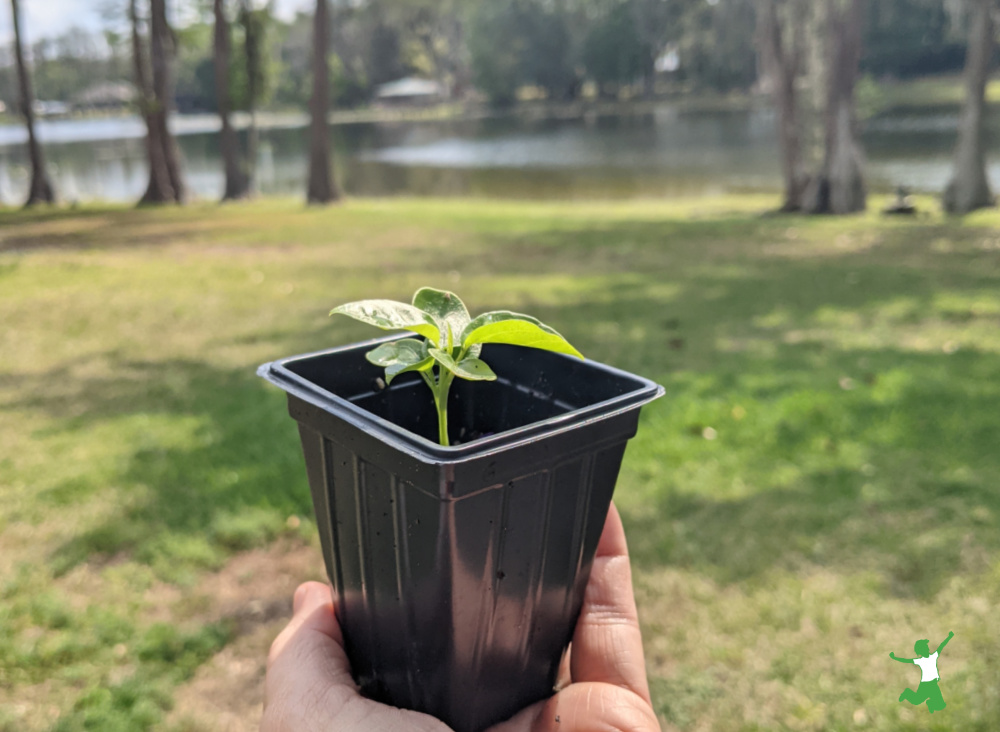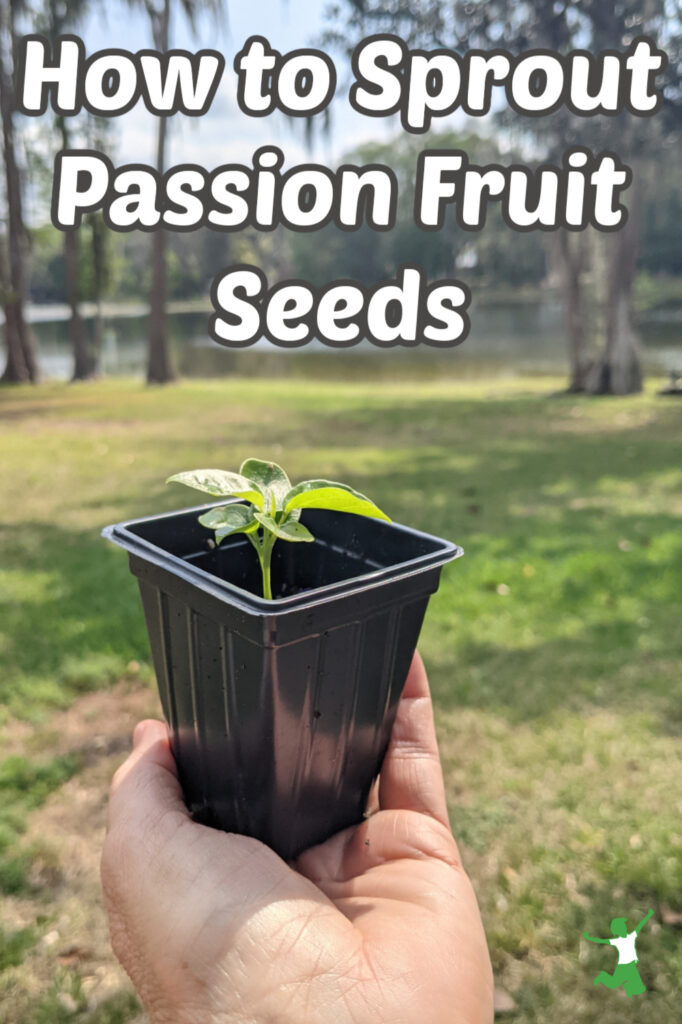How to prepare, sprout and grow passion fruit seeds to cultivate a prolific fruit-producing vine for your yard.

If you are looking to add a highly productive fruit edible to your yard, passion fruit is one of the best options to choose.
Best grown in tropical or subtropical climes, passion fruit vines also grow well trellised in a large pot indoors if your area regularly experiences frosts or freezing temperatures.
If the process goes smoothly, you can even have fruit within about 5 months!
The one downside of passion fruit is that they are difficult to sprout from seed…at least in my experience and from what others in my community have told me.
However, this is the optimal method to grow them if you want to keep the process inexpensive and avoid hybrid vines.
I recently wrote about the passion fruit custard recipe I developed after being gifted a couple dozen from a friend’s prolific vine in the community.
While some of the seeds I used to make a syrup topping for the custards, I saved some to sprout and grow into my own passion fruit vines for my yard.
I thought I would share my method in case some of you would like to tackle this gardening project this Spring.
Where to Find Passion Fruit Seeds
The best place to get passion fruit seeds is from a friend who has an established vine.
The second best place would be to buy a few fresh passion fruit at the farmer’s market or locally owned health food store when they are in season.
I even noticed local passion fruit on offer in the produce section of a Publix supermarket recently.
The reason I suggest getting them freshly grown locally is you can then be sure that the passion fruit variety you will attempt to sprout and grow will do well in your particular clime.
If neither of these options is available, then you can buy non-hybrid passion fruit seeds online in a pinch.
How to Grow Fresh Passion Fruit Seeds
There are a number of different ways to prepare fresh passion fruit seeds for planting.
One method shared by a friend suggests refrigerating them for a couple of weeks before planting to enhance the chances of sprouting!
I tried two different methods before hitting on an approach that worked quite well for me.
I had a 50% sprout rate, which I’m told is rather high given that fresh passion fruit seeds do not easily germinate unless you take steps to enhance the process.
Preparation
The first thing you will need to do to sprout passion fruit seeds is to remove them from ripened fruit.
To accomplish this, simply slice the fruit in half and scrape out the seeds, juice and pulp with a spoon.
After enjoying the juice and the pulp, rinse the seeds in filtered water. Use a paper towel to pat them dry and remove any remaining pulp with gentle abrasion.
At this point, you can try and plant them. However, I would suggest the additional step of soaking them overnight first.
Soaking significantly enhanced my sprouting success.
Soaking
We all know that soaking seeds overnight is an important preparation step before eating them.
This often overlooked, yet simple traditional method removes the antinutrients present in the hulls.
Better digestion and nutrient assimilation is the result.
As it turns out, soaking seeds overnight can also enhance the chances of sprouting too if cultivation is the goal.
While the warmth and moisture of the soil will naturally break down these antinutrients, you can boost your chances of success by removing these substances yourself by soaking them first.
Simply place the passion fruit seeds in a small glass jar and fill it with room temperature filtered water to cover.
After soaking the seeds overnight or up to 24 hours, carefully drain off the water and pat the seeds dry with a small cotton towel.
You’re now ready to plant!
Germination
I used organic potting soil from my local nursery in small seedling pots to sprout my prepared passion fruit seeds.
The picture above shows you the size of the containers.
Plant two passion fruit seeds about an inch deep in each container.
Keep the soil moist, but do not overwater or allow it to get too dry.
I applied a small amount of non-chlorinated water every day or every other day depending on the daytime temperatures.
If your nights are still quite cool (less than 60 °F/ 15 °C or so), I suggest keeping the containers indoors until the sprouts appear and are well-established.
I got a 50% germination rate which is apparently very good.
Note that it also takes a few weeks for the sprouts to appear. One of my seedlings didn’t emerge for a full month!
Don’t get discouraged if you don’t see the seeds germinate quickly, which is common with many other types of plants such as sprouted pumpkin seeds.
Replanting in the Yard
Once your seedlings are 6-8 inches tall, they are ready to replant.
The best place to do this is underneath an established tree on the south-facing side.
This way, the passion fruit vine can quickly grow up the side of the tree for support.
The tree also provides protection from frost if your area occasionally experiences colder temperatures.
The passion fruit vine will not kill the tree, so no worries about that!
If you don’t have any large trees that are suitable, a fence will work well too.
Passion fruit vines love full sun. However, in areas that are very hot in the summer like where I live, the partial shade of a tree is perfect.
I have magnolia and oak trees selected as the best spots for my passion fruit vines to grow.
Harvesting Ripe Fruit
I can’t wait to see how fast they grow through the summer and early Fall.
With any luck, I should have a plethora of fruit by then too!
Passion fruit are best gathered once they fall to the ground from the vine.
When they are wrinkled and old looking, they are at their sweetest and ready to eat!









Thanks for this helpful advice. I’m in maritime Canada and had bought a plant from an online herb nursery a few years back and it grew well outside, climbing up a trellis. It flowered as well. I got it to make a wonderful calming/sleep tincture from the leaves and flowers and that works very well. This time, I’ll try some in my large greenhouse.
I found some seeds on Etsy and the instructions said to scarify (rub with a nail file) the seeds first to lighten the coat and then to soak. I really like the paper towel method of sprouting seeds – damp paper towel or coffee filter inside an almost closed baggie, placed on a gentle heat source. Then I only plant the sprouted ones. It works for all seeds. Very effective and fast for peppers too and avoids those empty cell packs. Even if I don’t get fruit, (I had never thought of this until your article) the flowers are so beautiful, depicting Christ on the cross.
I would love to grow it but I am not in in tropical or subtropical climates
As mentioned in the article, you can grow on a trellis in a protected area.